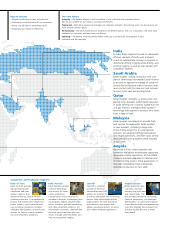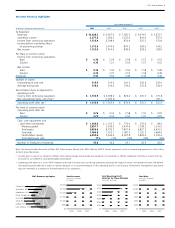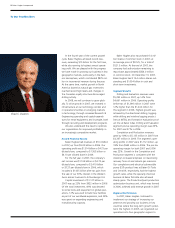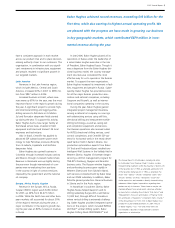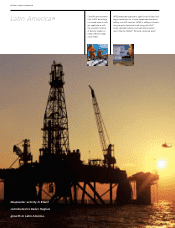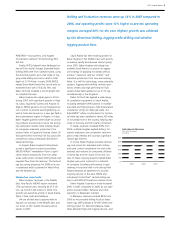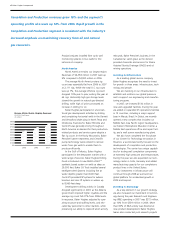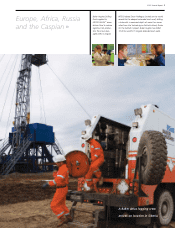Baker Hughes 2007 Annual Report Download - page 14
Download and view the complete annual report
Please find page 14 of the 2007 Baker Hughes annual report below. You can navigate through the pages in the report by either clicking on the pages listed below, or by using the keyword search tool below to find specific information within the annual report.
Most industry forecasts project that the world’s hydrocarbon demand
will grow by more than 50% in the next 20 years. To satisfy this grow-
ing energy need, oil and gas companies will require the innovation
and technologies from companies like Baker Hughes to meet the tech-
nical challenges of finding and producing hydrocarbons from new and
existing reservoirs.
North America Revenues
2005–2007, by Quarter
(In millions)
$1,200
$1,000
$800
$600
$400
$200
$0
2005 2006 2007
10 Baker Hughes Incorporated
The significant steps we have taken over
the past few years to strengthen our global
compliance program will play an important
role in reinforcing this company’s strong
reputation for integrity and ethical behavior.
For example, all management employees
and employees working in financial roles have
undergone required training regarding busi-
ness ethics and legal compliance, with partic-
ular emphasis on meeting the requirements
of the Foreign Corrupt Practices Act (FCPA).
In addition, we launched a global “Completely
Compliant” campaign to remind all Baker
Hughes employees of their obligation to com-
ply with all policies, laws and health, safety
and environmental requirements.
Now that we have settled the investiga-
tions with the DOJ and SEC, we are able to
pursue acquisitions, and refocus on imple-
menting our strategy for growth and profit-
ability. At the same time, the Deferred
Prosecution Agreement and the costs associ-
ated with the independent monitor and rigor-
ous compliance program will have an ongoing
impact on our business.
Optimizing the Organization
The Baker Hughes business model has
been based on strong product line divisions
focused on providing specific products and
services to our customers. In 2005, we
enhanced this approach by establishing two
segments and by aligning our global opera-
tions into four consistent regions with man-
agement teams closer to our customers. In
2007, we took several other steps to optimize
the organization to improve bottom-line
results and sustain growth.
To strengthen management visibility over
global operations, I asked our Group Presi-
dents, David Barr and Martin Craighead, to
each take financial responsibility for two of
our operating regions in addition to oversee-
ing their product line segments. David will
provide leadership for the Middle East, Asia
Pacific region and the Europe, Africa, Russia,
Caspian region and will office in Dubai for
six months of each year. Martin will lead the
North America and Latin America regions.
Our finance function was reorganized
so that division finance vice presidents now
report directly to the chief financial officer
instead of the business unit presidents to
improve efficiency and consistency and to
enhance our ability to comply with account-
ing regulations.
After a six-month evaluation, we restruc-
tured our Human Resources organization to
provide stronger direction from the corporate
center and to shift resources to support
region operations.
Late in the year, we named a new presi-
dent for our ProductionQuest business unit
and expanded its production optimization
role to include responsibility for integrated
services. Previously, our integrated operations
and project management group was focused
primarily on well construction activities. With
our customers’ increasing emphasis on max-
imizing recovery from existing fields, there
is a growing demand for production-related
project management, as well.
In 2008, we will balance our investment
in growth with a renewed effort at cost man-
agement, keeping a tight reign on administra-
tive costs and discretionary spending. We will
manage our headcount to match activity, and
we will continue to develop our local work
force internationally to control costs and to
increase our local content in countries where
we do business. We expect our Eastern Hemi-
sphere Education Center in Dubai to have a
strong positive impact by improving our ability
to train and develop employees from emerg-
ing markets.
Outlook
Looking ahead, the global fundamentals
for the upstream oil and gas industry remain
strong. Most industry forecasts project that
the world’s hydrocarbon demand will grow
by more than 50% in the next 20 years. To
satisfy this growing energy need, oil and gas
companies will increase their spending on
exploration, development and production.
They will require the innovation and technolo-
gies from companies like Baker Hughes to
meet the technical challenges of finding and


